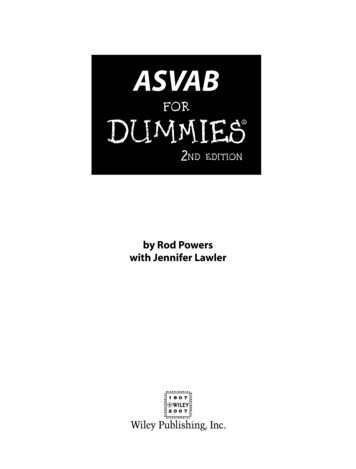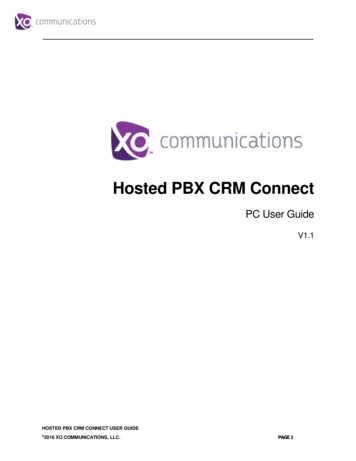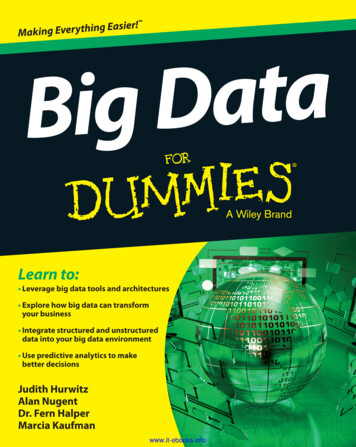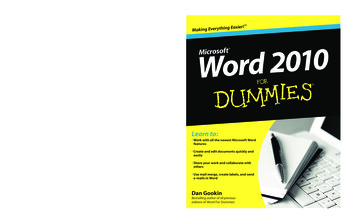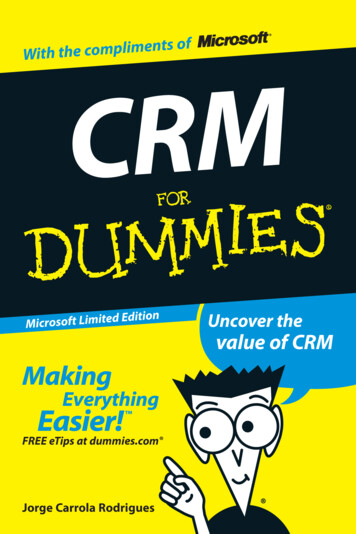
Transcription
These materials are the copyright of John Wiley & Sons, Inc. and anydissemination, distribution, or unauthorized use is strictly prohibited.
CRMFORDUMmIES‰MICROSOFT LIMITED EDITIONBy Jorge Carrola RodriguesA John Wiley and Sons, Ltd, PublicationThese materials are the copyright of John Wiley & Sons, Inc. and anydissemination, distribution, or unauthorized use is strictly prohibited.
CRM For Dummies , Microsoft Limited EditionPublished byJohn Wiley & Sons, LtdThe AtriumSouthern GateChichesterWest SussexPO19 8SQEnglandFor details on how to create a custom For Dummies book for your business or organisation, contact CorporateDevelopment@wiley.com. For information about licensing the ForDummies brand for products or services, contact BrandedRights&Licenses@Wiley.com.Visit our Home Page on www.customdummies.comCopyright 2012 by John Wiley & Sons Ltd, Chichester, West Sussex, EnglandAll Rights Reserved. No part of this publication may be reproduced, stored in a retrievalsystem or transmitted in any form or by any means, electronic, mechanical, photocopying,recording, scanning or otherwise, except under the terms of the Copyright, Designs andPatents Act 1988 or under the terms of a licence issued by the Copyright Licensing AgencyLtd, 90 Tottenham Court Road, London, W1T 4LP, UK, without the permission in writing ofthe Publisher. Requests to the Publisher for permission should be addressed to thePermissions Department, John Wiley & Sons, Ltd, The Atrium, Southern Gate, Chichester,West Sussex, PO19 8SQ, England, or emailed to permreq@wiley.com, or faxed to (44)1243 770620.Trademarks: Wiley, the Wiley logo, For Dummies, the Dummies Man logo, A Reference forthe Rest of Us!, The Dummies Way, Dummies Daily, The Fun and Easy Way, Dummies.comand related trade dress are trademarks or registered trademarks of John Wiley & Sons, Inc.and/or its affiliates in the United States and other countries, and may not be used withoutwritten permission. All other trademarks are the property of their respective owners. JohnWiley & Sons, Inc., is not associated with any product or vendor mentioned in this book.LIMIT OF LIABILITY/DISCLAIMER OF WARRANTY: THE PUBLISHER, THE AUTHOR, ANDANYONE ELSE INVOLVED IN PREPARING THIS WORK MAKE NO REPRESENTATIONS OR WARRANTIES WITH RESPECT TO THE ACCURACY OR COMPLETENESS OF THE CONTENTS OF THISWORK AND SPECIFICALLY DISCLAIM ALL WARRANTIES, INCLUDING WITHOUT LIMITATIONWARRANTIES OF FITNESS FOR A PARTICULAR PURPOSE. NO WARRANTY MAY BE CREATEDOR EXTENDED BY SALES OR PROMOTIONAL MATERIALS. THE ADVICE AND STRATEGIES CONTAINED HEREIN MAY NOT BE SUITABLE FOR EVERY SITUATION. THIS WORK IS SOLD WITHTHE UNDERSTANDING THAT THE PUBLISHER IS NOT ENGAGED IN RENDERING LEGAL,ACCOUNTING, OR OTHER PROFESSIONAL SERVICES. IF PROFESSIONAL ASSISTANCE ISREQUIRED, THE SERVICES OF A COMPETENT PROFESSIONAL PERSON SHOULD BE SOUGHT.NEITHER THE PUBLISHER NOR THE AUTHOR SHALL BE LIABLE FOR DAMAGES ARISING HEREFROM. THE FACT THAT AN ORGANIZATION OR WEBSITE IS REFERRED TO IN THIS WORK ASA CITATION AND/OR A POTENTIAL SOURCE OF FURTHER INFORMATION DOES NOT MEANTHAT THE AUTHOR OR THE PUBLISHER ENDORSES THE INFORMATION THE ORGANIZATIONOR WEBSITE MAY PROVIDE OR RECOMMENDATIONS IT MAY MAKE. FURTHER, READERSSHOULD BE AWARE THAT INTERNET WEBSITES LISTED IN THIS WORK MAY HAVE CHANGEDOR DISAPPEARED BETWEEN WHEN THIS WORK WAS WRITTEN AND WHEN IT IS READ.Wiley also publishes its books in a variety of electronic formats. Some content thatappears in print may not be available in electronic books.ISBN: 978-1-118-34565-8Printed and bound in Great Britain by Page Bros, Norwich10 9 8 7 6 5 4 3 2 1These materials are the copyright of John Wiley & Sons, Inc. and anydissemination, distribution, or unauthorized use is strictly prohibited.
Table of ContentsIntroduction . 1About This Book .1Foolish Assumptions .2How This Book Is Organised .2Icons Used in This Book.3Where to Go from Here .3Part I: What Is CRM? . 5CRM at a Glance .5CRM: The Details .6Types of CRM Solutions .7Part II: Improving Sales Management andPipeline Control . 9Reaping the Benefits of CRM .9Looking at CRM and Account Management.10Improving Sales Management, Productivityand Planning .11Integrating Opportunity Automation Management .12Increasing the Efficiency of Opportunityand Pipeline Management .12Part III: Making the Most Out ofMarketing and Loyalty . 15Making Segmentation Easy .16Planning and Executing Campaigns.16These materials are the copyright of John Wiley & Sons, Inc. and anydissemination, distribution, or unauthorized use is strictly prohibited.
ivLooking at Campaign Results and Opportunities .17Keeping Customer Satisfaction in Mind .18Looking at Contract Management, Case Supportand Service Planning.18Integrating Mobility and Services .19Part IV: Exploring Social CRM,Mobile CRM and XRM . 21Getting the Inside Scoop on XRM .21Benefiting from Mobile CRM.23Taking Advantage of Social CRM .24Part V: Ten (Well, Nearly) Top Tips for CRM . 27Try Before You Buy .27Reflect and Analyze .28Identify Organisations Using CRM .28Avoid Dual-Systems Installations.28Identify Your CRM Champions .28Choose Professionals to Help You .29Ask for ROI and Payback Evidences .29Don’t Tie CRM to Traditional SoftwareCapital Investments .29These materials are the copyright of John Wiley & Sons, Inc. and anydissemination, distribution, or unauthorized use is strictly prohibited.
IntroductionCRM For Dummies introduces a software tool thathandles customer sales and marketing in an easyto-use environment so that you can be more productive at sales, execute campaigns near your customerbase and serve your customers better. Maybe youalready use a CRM application. Or maybe you thoughtyour Outlook was a CRM system (which it’s not). Ormaybe you think CRM is limited to large enterprises,which it’s not by all means.In this book, you get acquainted with a software toolthat can be as easy to use as Outlook, totally integratedso that you almost don’t know the difference while atthe same time being both practical and operational.You’re also introduced to the new flavors of CRM, suchas Social CRM, Mobile CRM, or XRM. Customer intimacy is key for loyalty and increased sales, and todayyou already have CRM that was built based on howyou work!About This BookIn this book, you discover information about functionalities that will improve the way you handle customercontacts, leads, opportunities and case resolution.These out-of-the-box functionalities can make yoursales and marketing processes more effective and efficient. Thanks to free trials, you’ll be ready to put yourhands on and experience the power of operational CRMfor you and your organisation.These materials are the copyright of John Wiley & Sons, Inc. and anydissemination, distribution, or unauthorized use is strictly prohibited.
2Foolish AssumptionsHere are some assumptions made about you whenwriting this book: You work in management, sales, marketing orcustomer service. You want to be more efficient on getting leads,closing opportunities, controlling the pipelineaccuracy, growing more satisfied and repeatablecustomers and saving money (all at the sametime). You’re familiar with CRM, but think it isn’t simpleto use or acquire.How This Book Is OrganisedCRM For Dummies is divided into five small but perfectly formed parts: Part I: What Is CRM? — Head here for a quick introduction on what operational CRM may be and someof the most common functional areas covered. Part II: Improving Sales Management andPipeline Control — This part shows you howCRM handles accounts, opportunities and pipelinemanagement for more effective sales. Part III: Making the Most Out of Marketing andLoyalty — In this part, you discover how CRMhelps build campaigns, gets results and fills thepipe of opportunities to hand over to sales. Youalso find out how you can use CRM to improvecustomer service, post-sales and contractmanagement.These materials are the copyright of John Wiley & Sons, Inc. and anydissemination, distribution, or unauthorized use is strictly prohibited.
3 Part IV: Exploring Social CRM, Mobile CRMand XRM — In this part, you see how CRM hasextended its reach both from inside the organisation to everywhere, anytime and beyond customers to any type of entity relationship management. Part V: Ten (Well, Nearly) Top Tips for CRM —No For Dummies book is complete without thelighthearted Part of Tens, and this book is noexception. This part highlights key points toremember as you jump into the world of CRM.Icons Used in This BookThe following icons highlight important text:This icon warns you of common mistakes toavoid.The knotted string highlights important information to bear in mind.Home in on the target for tips to enable you toget better sales and marketing processes.Where to Go from HereAs with all For Dummies books, you can either read thisguide from cover to cover or flick straight to the section that interests you. Whether you read it in smalldoses using the section headings or all in one long session, you’ll find plenty of information to get you onyour way to use CRM as a tool for better customermanagement and sales.These materials are the copyright of John Wiley & Sons, Inc. and anydissemination, distribution, or unauthorized use is strictly prohibited.
4These materials are the copyright of John Wiley & Sons, Inc. and anydissemination, distribution, or unauthorized use is strictly prohibited.
Part IWhat Is CRM?In This Part Understanding what CRM is Exploring the different types of CRM solutionsCRM is often thought to be just software tools, butCRM helps you and your business focus on yourcustomer. In this part, you find out what CRM truly is.CRM at a GlanceCRM (Customer Relationship Management) emerged inthe late ’90s as a business strategy centered around thecollection and handling of information related to customer relations and transactions, supported by a technological solution. CRM is a supplemental solution tothe most usual core applications in order to extractadded value from existing customer data.Usually, an organisation’s core of applications consists of Transactional applications: Transactional applications, which take place, for example, in a bankor a shop, are the applications used in the frontoffice or counter to handle the transactionsbetween the organisation and the customer.These materials are the copyright of John Wiley & Sons, Inc. and anydissemination, distribution, or unauthorized use is strictly prohibited.
6These applications usually don’t collect andhandle customer or prospect information orcustomer relations and interactions. Management or accounting applications: Theseapplications are used in the back office to consolidate data necessary to accomplish accountingobligations, among others, or to help the management of the organisation in areas such as financialmanagement, logistics, production or humanresources.CRM: The DetailsCRM is an integrated management system focused oncustomers and prospective customers. It contains theprocesses and procedures that build a business management model centered on a 360º approach to thecustomer.The management processes in which CRM is based areundoubtedly at the forefront in terms of strategy andmarketing, and also at the economic and financial level.Indeed, companies that are thoroughly familiar withtheir customers can create custom responses, anticipating their wants and needs and answering theirmajor wishes.In order to build a smarter CRM strategy, the technologyresponds only to the company’s strategy by helping tocapture data about the client and external sources andconsolidate that data in a central data-warehouse.Additionally, integrated marketing and informationtechnologies provide the company with integrated andeffective means of meeting, recognising and caring forthe client in real time. CRM applications transform theThese materials are the copyright of John Wiley & Sons, Inc. and anydissemination, distribution, or unauthorized use is strictly prohibited.
7data collected into information that allows a betterunderstanding of the customer profile.The CRM platforms build on customer-centric processes, disseminated throughout the organisation.CRM extensively uses information related to the clientby integrating the areas of marketing, sales and serviceand verifying the creation of customer value.Before you implement CRM, you need to understand what model of customer relationshipsthe company intends to adopt and which customer care processes need to be redesigned.Types of CRM SolutionsThere are several types of CRM solutions: Collaborative CRM: Aimed at sharing informationon various types of interactions that customershave with the organisation and its differentdepartments, either through direct interactions,by email, by letter or by fax. Analytical CRM: Functions include performanceanalysis and business intelligence. The analyticalCRM lets you work all the specific informationabout how the various customer segments like tobe treated. Operational CRM: The application interactsdirectly with the customer by integrating the frontoffice, back office and mobility. This type includesthe functional areas of sales force automation,contact management, automation of marketingactivities and customer service.These materials are the copyright of John Wiley & Sons, Inc. and anydissemination, distribution, or unauthorized use is strictly prohibited.
8This book focuses on the Operational CRM,which addresses mainly Salesforce automation and contact management Marketing automation Customer service automationThese materials are the copyright of John Wiley & Sons, Inc. and anydissemination, distribution, or unauthorized use is strictly prohibited.
Part IIImproving Sales Managementand Pipeline ControlIn This Part Taking a look at CRM and account management Refining sales management, productivity andplanning Integrating opportunity automation management Increasing opportunity and pipeline managementAdd CRM as a tool, and you and your salesforcewill begin to reap the many benefits. You’ll notonly enjoy increased sales, but a smoother and moreefficient sales process. And those benefits are just thebeginning!Reaping the Benefits of CRMGetting more sales and winning more deals are themajor drivers for growth in organisations. Enhancedsales productivity is why salesforce automation isamong the most demanded areas to start implementinga CRM.These materials are the copyright of John Wiley & Sons, Inc. and anydissemination, distribution, or unauthorized use is strictly prohibited.
10With an efficient and easy-to-use sales managementtool, the sales managers enjoy dramatic improvementsin the sales cycle control, close rates and current information about sales performance.A CRM system that is totally integrated withthe most common productivity tools, such asword processors, spreadsheets and email, andthat has embedded integration of all contactsis a powerful tool for the salespeople, and theadoption is almost immediate.Looking at CRM and AccountManagementAccount and contact management are positivelyimpacted with the usage of a CRM system with thepossibility to Keep consistent and updated information abouteach customer account and contacts, avoidingduplications and different views of the same contact or account. Monitor all activities and interactions with eachcontact and account. Pinpoint the opinion leaders, supporters andblockers in each account. Identify instantly possible crossed opportunitiesin each account. Receive alerts regarding contract renewals andactivities to be performed in programmed periodsbefore the due dates.These materials are the copyright of John Wiley & Sons, Inc. and anydissemination, distribution, or unauthorized use is strictly prohibited.
11Improving Sales Management,Productivity and PlanningSales management, productivity and planning areenabled in a CRM system. As a result, you can Use the CRM tool integrated with your MicrosoftOffice Outlook. Find immediately the information you need in visualisation panels, where you can access contacts(including those recently used) and contact lists. Improve team communication and collaborationdealing with customer organisations, throughtransparent integration with productivity, collaboration and portal technologies. Reduce time cycles in data import uploads andkeep quality data with duplications removed. Use the most updated CRM data in MicrosoftOffice Excel with bidirectional synchronisation ofdata. Easily build sales and territory teams in order tocreate a more effective organisation. Create list prices with allowed discounts for specific groups of customers in order to simplify proposals management. Have a resource center built into the CRM whereyou can gather sales best practices andrecommendations. Use consistent permissions based on functionalroles and groups, which makes distributing information easier and faster.These materials are the copyright of John Wiley & Sons, Inc. and anydissemination, distribution, or unauthorized use is strictly prohibited.
12Integrating OpportunityAutomation ManagementConnected sales and marketing processes are an areathat CRM also helps improve.A proper CRM decreases the black hole of leads thatare handed over from marketing activities to the insidesales and sales teams, making it easy to follow up,based on predefined rules.The marketing activities already loaded into the CRMare integrated in a process workflow that significantlyreduces the generated leads and that are unprocessedby sales or inside sales.The CRM also lets you easily identify new opportunitiesbased on the immediate segmentation of the database.Increasing the Efficiency ofOpportunity and PipelineManagementOpportunity and pipeline management areamong the areas that suffer a dramaticincrease of efficiency with a proper CRMimplementation.You can shorten the sales cycle while also increasingcustomer and prospect satisfaction simply by sendingproposals and sales agreements faster. The CRM is ableto store or integrate with a repository of template standard documents that are instantly fulfilled with thespecific conditions for the proposal under discussion.These materials are the copyright of John Wiley & Sons, Inc. and anydissemination, distribution, or unauthorized use is strictly prohibited.
13You should look at several aspects of a state-of-the-artand easy-to-use CRM software: Establish consistent sales processes across theenterprise with predefined workflows. Look at a CRM that integrates directly sales methodologies, such as Miller Heiman, SPI and TAS. Identify and take advantage of potential influencers in the sales process (for example, lawyers andconsultants). Position yourself more effectively against thecompetition with a continuous monitoring of thecompetitor. Identify the main trends of negotiations won orlost and optimise sales processes. Improve financial planning through greater control and predictability of the sales pipeline. Increase the accuracy of revenue projections withindividual or combined forecasts. Use predefined criteria to control the revenuetargets by date or fiscal periods. Instantly control sales quotas compared with theperformance both by individual salesperson or bygroup of salespeople.These materials are the copyright of John Wiley & Sons, Inc. and anydissemination, distribution, or unauthorized use is strictly prohibited.
14These materials are the copyright of John Wiley & Sons, Inc. and anydissemination, distribution, or unauthorized use is strictly prohibited.
Part IIIMaking the Most Out ofMarketing and LoyaltyIn This Part Simplifying segmentation Getting the most out of campaigns Knowing what to look for in contract management,case support and service planning Remembering mobility and servicesMarketing automation is one other important areaof an operational CRM. Very often, the organisations have a database of customer or prospect contactsand want to promote their offer on these but don’t knowhow to do so. The marketing solution of the CRM shouldbe very flexible and easy to use, allowing you to sellmore efficiently while improving productivity.In addition, if your customers aren’t happy, then youhave problems. Fortunately, CRM even helps you makeyour customers not only happy but coming back formore.These materials are the copyright of John Wiley & Sons, Inc. and anydissemination, distribution, or unauthorized use is strictly prohibited.
16Making Segmentation EasyEasy segmentation and contact management is possible with a CRM, which Uses natural language for customer informationretrieval and segmentation. Creates contact lists that are focused and associated to campaigns. Creates reusable personal and public views. Easily shares marketing lists with other teammembers. Uses lists for mass email marketing or mail mergeprinting.Planning and ExecutingCampaignsThe CRM allows you to simplify campaign planning andexecution with Marketing plans easily created with integrateddocument management resources. Planning and control of activities, tasks, budgetsand details for each marketing activity. The possibility to create product catalogs and listprices inside the CRM. Easily adaptable messages and unsolicited proposals for highly targeted lists. Reusable campaign templates that save time andmoney.These materials are the copyright of John Wiley & Sons, Inc. and anydissemination, distribution, or unauthorized use is strictly prohibited.
17 Predefined workflows to streamline processes andapprovals. The possibility to initiate and distribute campaigns and communications instantly. A central platform that allows you to control andmanage all details of campaigns and clients. Rules created to react and give answers based oncustomer interests.Looking at Campaign Resultsand OpportunitiesThe goal of campaign execution is to generateresponses that translate into added business opportunities. So it is important that the CRM solution is ableto monitor and manage the feedback from the campaigns, centralising these results and then automatically converting campaign responses into leads andthen distributing those leads automatically to the salesresources according to specific rules.The potential opportunities generated from campaignsshould be easily controlled in the CRM, with Improved coordination between sales and marketing, with both having a common view on the CRM. Automatic promotion of the most interestingleads to be processed by inside sales or othersalespeople.These materials are the copyright of John Wiley & Sons, Inc. and anydissemination, distribution, or unauthorized use is strictly prohibited.
18Keeping Customer Satisfactionin MindModern CRM solutions handle not only sales but alsoservices. It is important for customer satisfaction andloyalty and sales productivity that information aboutissues, cases or incidents and contracts is also handledthrough the same solution.The sales team has a total view on the customerand won’t try to push a sale if, for instance, acustomer has an issue to be solved that isaffecting his satisfaction.Customer service, on the other hand, knows which customers should be supported and their value to theorganisation. It is possible to have a real customervalue based on the margin released from sales less thecosts associated with sales and support.Some of the functionalities available in a servicesmodule of a CRM include maintenance contracts management, case support and knowledge bases, resourceplanning and full-time availability to mobileworkforces.Looking at ContractManagement, Case Supportand Service PlanningContract management, case support and service planning functionalities available in CRM should includeThese materials are the copyright of John Wiley & Sons, Inc. and anydissemination, distribution, or unauthorized use is strictly prohibited.
19 Usage of workflows to launch activities that support distribution of the cases among the agentsaccording to the right level of service. Management of incidents distribution throughindividual and team queues. Full access to customer data and incident so thatyou have quicker response times. Rule-based approvals and escalations to route theincident to the correct person. Increased first-time case resolution with the internal repository of knowledge. Capability to program services and resources toserve customers efficiently. Connection to teams with a centralised view ofcalendar and services. Monitoring and measurements of the performanceof organisations, business units, teams andindividuals. Detailed analyses and updated key performanceindicators (KPI).Integrating Mobilityand ServicesOne other important feature in today’s services moduleof a CRM is the level of integration allowed with mobility devices. This is also a great enabler for increasedproductivity, giving the possibility toThese materials are the copyright of John Wiley & Sons, Inc. and anydissemination, distribution, or unauthorized use is strictly prohibited.
20 Distribute reports and alerts via mobile devices. Manage and update schedules and servicecommitments. Access and send data from the CRM customer service through any Web-enabled device.These materials are the copyright of John Wiley & Sons, Inc. and anydissemination, distribution, or unauthorized use is strictly prohibited.
Part IVExploring Social CRM,Mobile CRM and XRMIn This Part Looking at XRM Reaping the benefits of mobile CRM Keeping in mind social CRMYou may have heard of XRM, but not know what itis or how it compares to CRM. In this part, you canfind out the inside scoop of what XRM really is and howit relatesto CRM.Getting the Inside Scoopon XRMCRM software has become a necessity for many largecompanies, enabling them to more effectively managecustomer relationships. As CRM matured, companiesrealised that an effective CRM solution must Be highly flexible to meet the needs of thebusiness.These materials are the copyright of John Wiley & Sons, Inc. and anydissemination, distribution, or unauthorized use is strictly prohibited.
22 Allow organisations to manage a wide range ofentities, including not just customers but alsoleads, prospects, contacts and cases. Include automation of business processes relatedto customer management.The result was a different kind of CRM that is highlyflexible,automated, and customisable – in effect, aRelationship Management-based platform.As businesses expanded their use of this different kindof CRM solution, they began to use them to manage awider range of entities – not just customer relationships, but also asset management, prospect management, citizen management and many more. What beganas a CRM solution was adapted to be the platform formultiple business applications built around core CRMcapabilities.This extension from customer-centric to X-centricapplications is the origin of the term XRM. Table 4-1summarises the differences.Table 4-1Comparing CRM and XRMCRMXRMDefinitionC customer; managecustomers through theautomation of marketing, sales and serviceprocessesX any business entity;make any businessrelationship throughthe automation ofrelevant business unitprocessesUsed byMarketing, sales andcustomer serviceteamsAny teamThese materials are the copyright of John Wiley & Sons, Inc. and anydissemination, distribution, or unauthorized use is strictly prohibited.
23CRMTo manage Customer relationshipsXRMAny relationshipAutomatesMarketing, sales andservice processesAny business processTracksInteractions, activities,tasks and 360 historyof the customerInteractions, activities, tasks and 360 history of XProvidesCustomer-centricanalyticsX-centric analyticsCompanies can use XRM in a wide range ofmanagement fields and processes, as VRM(Vendor), ERM (Employee), PRM (Partner),CzRM (Citizen) and so on.Benefiting from Mobile CRMA Mobile CRM application offers the ability to providerobust CRM features that allows field workers, such assalespeople, service staff and support teams, to accessand interact with customer data while they’re on theroad. Using smartphones, tablets and other Webenabled handheld appliances, users can retrieve andupdate customer-related information from back-endsystems, manage opportunities and jobs, processorders, check inventory levels and much more, just aseasily as if they were in the office.The Mobile CRM complements the CRM systemused inside the organisation. You can have aCRM anytime, anywhere, on the move, so thatyou’re nearer and nearer the customer.T
CRM For Dummies , Microsoft Limited Edition Published by John Wiley & Sons, Ltd The Atrium Southern Gate Chichester West Sussex PO19 8SQ England For details on how to create a custom For Dummies book for your business or organisa-tion, contact CorporateDevelopment@wiley.com. For information about licensing the ForFile Size: 2MB




